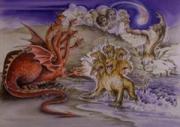And the Survey Says . . . The Antichrist Is . . .
 Saturday, June 3, 2006 at 06:50PM
Saturday, June 3, 2006 at 06:50PM  In a recent survey on sermonaudio.com (h.t. to Paul and Luann), people gave the following answers to the question, "who is the Antichrist?" Over four hundred people voted. Here are their answers . . .
In a recent survey on sermonaudio.com (h.t. to Paul and Luann), people gave the following answers to the question, "who is the Antichrist?" Over four hundred people voted. Here are their answers . . .
| • | A Future Man to Be Revealed  52% · 268 votes 52% · 268 votes |

| • | The Office of the Pope  24% · 122 votes 24% · 122 votes |

| • | An Invisible Yet Known Presance  3% · 18 votes 3% · 18 votes |

| • | All of False Religion  10% · 54 votes 10% · 54 votes |

| • | The Anti-Christ Has Come and Gone  4% · 21 votes 4% · 21 votes |

| • | No answer. Skip this survey, I do not care to vote on this topic. |
In my book, The Man of Sin, I attempt to make the case that the church has faced many "antichrists" from the days of the apostles (1 John 2:18, 22; 4:3; 2 John 7).
I also contend that the beast from the land is imperial Rome (Revelation 13:1-10) and the beast from the sea is the emperor cult in Asia Minor (Revelation 13:11-18) when John was given the vision we now know as the Book of Revelation, about A. D. 95. The dragon empowers the state and its leader (the false prophet) to turn on all those who confess "Jesus is Lord." To confess "Jesus is Lord" is to simultaneously confess that "Caesar isn't!"
John implies that what is represented by the beast (a satanically energized state waging war on the church) will reoccur throughout the course of this age (Revelation 17:9-18), and will finally culminate in a great apostasy and out-pouring of evil at the end of this age (Revelation 20:7-10), when Satan is released from the Abyss, only to go to his final destruction.
Paul's discussion of the "man of sin" (lawlessness) in 2 Thessalonians 2:1-12, fits with this as well. Paul speaks of someone in the church (the temple of God--which I believe is not a reference to the temple in Jerusalem, either in AD 70 or in the future), who proclaims himself God, demands worship, and deceives many through Satanic power. Paul likewise ties this to a final apostasy (2 Thessalonians 2:3). While image of a deceiver in the church surely fits with the papacy (which is an antichrist institution), Paul ties the revelation of this particular individual to the time of the end (2:8). The appearance of the man of sin and the final apostasy are harbingers of the end.
So, how would I vote in the poll? Because there is a certain sense in which Antichrist is a past, present, and future phenomena, if I could, I'd say "yes" to points 1, 2, and 4, and "no" to point 5, "the Antichrist has come and gone."
 Kim Riddlebarger
Kim Riddlebarger

Thanks to Drs. Ligon Duncan and Derek Thomas for the nice plug over on the Reformation 21 blog! Click here: Reformation21 » Reformation 21 Blog






















